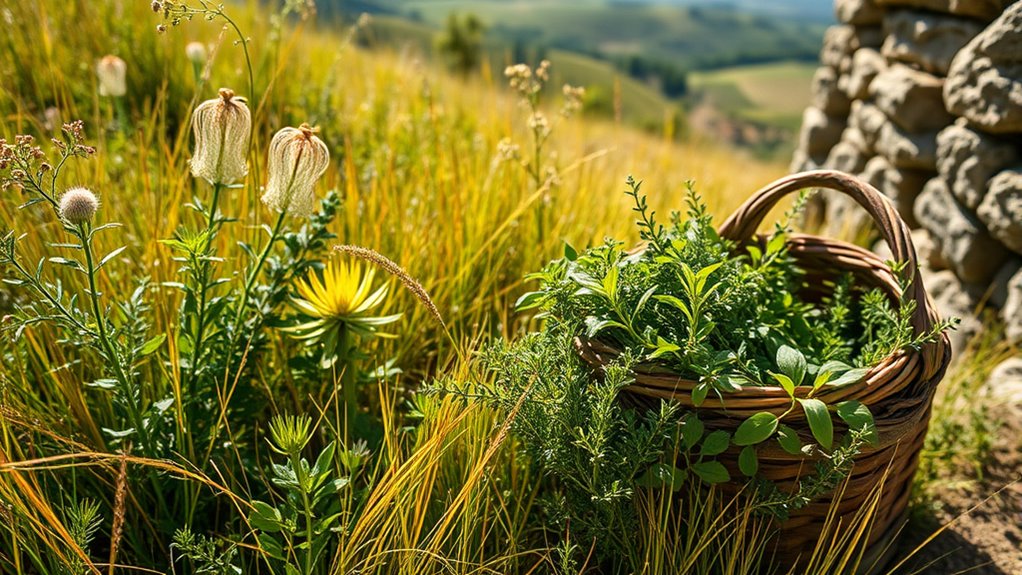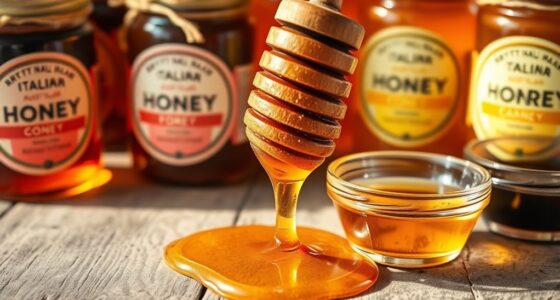To forage wild herbs in the Italian countryside, start by learning to correctly identify plants like wild basil, rosemary, and savory, paying attention to features like leaf shape, flower color, and growth habits. Respect the environment by harvesting sustainably, avoiding protected areas, and only taking what you need. Use safe techniques and double-check your identifications to avoid toxic look-alikes. If you keep exploring, you’ll uncover even more ways to gather herbs responsibly and enjoy their flavors.
Key Takeaways
- Learn to accurately identify native Italian herbs by studying reliable guides and observing key features like leaves and flowers.
- Understand local ecology and habitats to locate herbs such as wild basil, rosemary, and savory naturally.
- Practice ethical foraging by harvesting sustainably, respecting land ownership, and avoiding over-harvesting.
- Use proper tools and double-check plant identification to ensure safety and avoid toxic look-alikes.
- Approach foraging with patience, respect, and mindfulness to enjoy the experience while supporting conservation efforts.

Have you ever considered the rewarding adventure of foraging wild herbs? Exploring the Italian countryside offers a unique chance to connect with nature and discover vibrant, aromatic plants that grow freely in the wild. But before you start harvesting, it’s essential to master herb identification. Learning how to accurately identify herbs ensures you pick the right plants and avoid dangerous look-alikes. Pay attention to leaf shape, flower color, and growth patterns—these details are crucial for safe foraging. It’s tempting to pick every green plant you come across, but a keen eye and proper knowledge can make the difference between a delicious herb and a toxic imposter. Take your time to study reputable guides, join local foraging groups, or even take a workshop if available. Developing a solid understanding of herb identification lays the foundation for a safe and enjoyable experience.
Additionally, understanding the local ecology and plant habitats can significantly improve your foraging success and help you identify native plant species more accurately. Alongside identification, practicing ethical foraging is vital. Respect the environment by harvesting responsibly, which means taking only what you need and leaving plenty behind for the plants to regenerate. Avoid damaging the roots or over-harvesting from a single patch; this helps maintain the health of the ecosystem and ensures herbs continue to thrive for future foragers. Be mindful of private land, always seek permission if necessary, and adhere to local regulations. Ethical foraging practices also include leaving no trace—dispose of waste properly and avoid disturbing wildlife. Remember that wild herbs are a vital part of the natural landscape, providing food and shelter for many creatures, so tread lightly.
As you wander through sun-dappled fields or shady woodland edges, keep your senses alert for the subtle signs of herbs like wild basil, rosemary, or savory. Use a small knife or scissors to harvest stems cleanly, and always double-check your identification before consuming any plant. If uncertain, it’s better to leave it be than risk poisoning yourself. The Italian countryside is teeming with edible treasures, but patience and respect are your best tools. By honing your herb identification skills and practicing ethical foraging, you’ll not only gather flavorful wild herbs but also contribute to the preservation of these precious natural resources. So, embrace the journey, stay curious, and enjoy the rich flavors that the Italian wild offers—safely and sustainably.
Frequently Asked Questions
Are There Any Legal Restrictions on Foraging in Italy?
You should be aware that legal considerations in Italy can affect your foraging activities. While some areas allow for wild herb collection, others may require foraging permits or have restrictions to protect local ecosystems. Always check local regulations before you start collecting, as unauthorized foraging can lead to fines or penalties. To stay safe, respect protected zones and obtain necessary permits if required, ensuring your foraging is both enjoyable and legal.
Which Herbs Are Safest for Beginners to Identify?
When it comes to herb identification for beginner safety, start with common herbs like chamomile, mint, and basil. These plants are easier to recognize, have distinctive smells, and are less likely to be confused with toxic look-alikes. Always double-check your identification with a reliable guide or app, and harvest in areas free from pollution. Being cautious guarantees you enjoy foraging safely while learning to identify herbs confidently.
How Do I Sustainably Harvest Wild Herbs?
Oh, you’re about to become a hero of the herbal world—minus the villainy of overharvesting! To harvest sustainably, use ethical foraging practices: pick only what you need, leave enough for the plants to thrive, and avoid damaging roots. Stick to sustainable harvesting methods like cutting above the root zone. Respect nature’s balance, and you’ll enjoy wild herbs today and tomorrow. Keep it green, keep it kind.
What Are the Best Seasons for Foraging Specific Herbs?
You should focus on seasonal herb availability to maximize your foraging success. Each herb has ideal foraging months; for example, wild garlic is best in early spring, while thyme peaks in summer. To guarantee sustainable harvesting, learn the specific timing of herbs’ growth cycles, so you can enjoy fresh, flavorful herbs while protecting plant populations. Planning your foraging trips around these prime months helps you gather herbs at their peak.
Can Foraging Wild Herbs Be Harmful Without Proper Knowledge?
Foraging wild herbs can be harmful if you lack proper knowledge because misidentification risks are high. You might accidentally pick poisonous plants that look similar to edible ones, leading to potential poisoning. Without accurate identification skills, you could consume dangerous herbs. Always learn from trusted sources or experienced foragers, and avoid guesswork. This way, you protect yourself from harmful effects caused by poisonous plants and ensure a safe foraging experience.
Conclusion
So, next time you wander the Italian countryside, why not pretend you’re a secret herb spy? Snatch wild greens like a culinary James Bond, all while avoiding the unassuming nettle traps. Just remember, Mother Nature’s got a mischievous sense of humor—she’ll give you a tasty treat or a sneaky sting. Embrace the chaos, revel in the adventure, and turn foraging into your own delicious, slightly rebellious Italian escapade. Buona fortuna, herb hunter!









